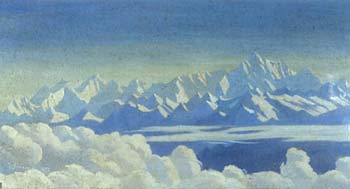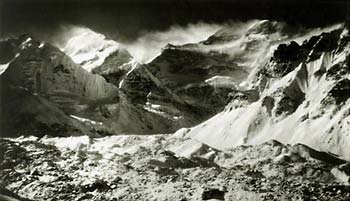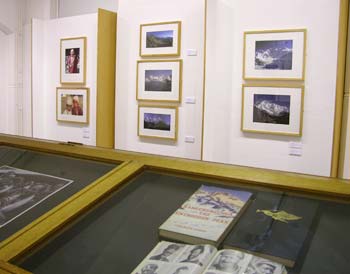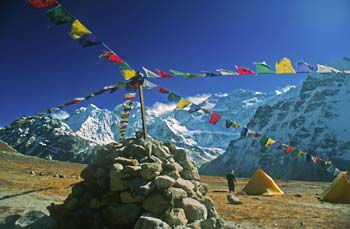
  Contact DetailsSchool of Art |
Kangchenjunga: Imaging a Himalayan Mountain4 July – 16 September 2005This exhibition of photographs, paintings and prints of the celebrated mountain Kangchenjunga took place in the School of Art Galleries to coincide with the 50th anniversary of the first ascents in May 1955 by a team of British climbers. The exhibition, curated by Simon Pierse, was been jointly organized by the Alpine Club and The University of Wales, Aberystwyth.  T. Howard Somervell, Kangchenjunga from Darjeeling, 1932 The exhibition and accompanying catalogue surveys the history of Kangchenjunga as a pictorial and literary subject and examine the differing ways in which it has been seen and interpreted by British and European artists, photographers, mountaineers, poets, authors and travel-writers over the period c1848–2005.  Uli Wieland, Kangchenjunga NW Face from Base Camp, 1930 The third highest mountain in the world (8586 m., 28,169 ft.) has been a topographical feature to be sketched, mapped and surveyed; it has been seen as an emblem of colonial possession; later an embodiment of the sublime, a picturesque motif, a mountaineering challenge, a peak conquered but left un-trodden; and recurrently throughout all of these, a sacred mountain and symbol of spirituality. Added to all of these ways of seeing Kangchenjunga is the significance of the mountain to the Nepalese and Sikkimese people who live in its shadow, and to whom the mountain is symbolically the residence of a god.  View of exhibits at the exhibition. Many have been captivated by Kangchenjunga’s magnificence, its transient and ethereal qualities, hovering, as it sometimes appears to, half-hidden above the clouds and indeed sometimes even mistaken for a cloud. As a subject Kangchenjunga has an important place, not only in the history of British mountaineering, but also within the sublime and romantic traditions of British and European art.  Steve Razzetti, Prayer Flags at Pangpema, 2000 Exhibition Catalogue  Recent acquisitions 1999 - 2001 | Exhibitions during 1999 | Exhibitions during 2000 | Exhibitions during 2001 | Exhibitions during 2002 | Exhibitions during 2003 | Exhibitions during 2004 | Exhibitions during 2005 | Exhibitions during 2006 | Exhibitions during 2007 | Exhibitions during 2008 | Exhibitions during 2009 | Alexander Adams | Alistair Crawford | Alistair Crawford - Landscape Capriccios | Alistair Crawford - Even Smaller Room | Alumni | Anne Desmet | Art on the Town | Bernard Cheese | Bodywork | British Artists in Italy | Centenary Artists | Chris Penn | Christina Edwards | Christopher Vranek | Claudia Williams | Colin Jones | Current Exhibitions | David Tinker | Undergraduate Degree Show and Postgraduate Exhibition 2005 | 2009 Degree Show | Derek Williams Collection | Derrick Greaves | Earth and Sky | John O\'Rourke: East-West-Occult | eBay | Edgar Holloway | Edwina Ellis | Elfyn Lewis | Erich Lessing | Evelyn Gibbs | Forthcoming Exhibitions | Future Plans | Germano Ovani - A Bunch of Peculiars | Gregynog Exhibition - John Roberts | Gwilym Pritchard | Inspire! Exhibition | Catrin Webster | Jane Joseph | Jenny Martin | John Roberts | Joseph Webb | Kate Hammersley - Mikro Kosmos | Kate Hammersley - Order and Chaos | Ken Elias | Klaus Friedeberger | Simon Pierse | London Life | Looking out to Sea | Marcelle Hanselaar - Down the Rabbit Hole | Ross Martin and Thomas Michael Harrison | Mutations - work by six women artists from Sardinia | Edgar Holloway and his Contemporaries | Pam Berridge | Past Exhibitions | Paul Croft | 17 Prime Makers | Recent Acquisitions | Recent Acquisitions 2000 - 2008 | Richard Weis | Robert Greetham - Of Fire and Rites | Royal Society of Painter - Printmakers | Sankofa - Ceramic Tales from Africa | The Sea | Brush Up Your Shakespeare | Sidney Nolan | Sisters Select | Stuart Pearson Wright | Terra Incognita - Images of Australia | Thomas Williams | Tony Heward | Touring Exhibitions | Anne Desmet - Urban Evolution | Vicky Shaw | Vicky Shaw Biography | Christopher Webster - Visions and Traces | William Stevens Recent acquisitions 1999 - 2001 | Exhibitions during 1999 | Exhibitions during 2000 | Exhibitions during 2001 | Exhibitions during 2002 | Exhibitions during 2003 | Exhibitions during 2004 | Exhibitions during 2005 | Exhibitions during 2006 | Exhibitions during 2007 | Exhibitions during 2008 | Exhibitions during 2009 | Alexander Adams | Alistair Crawford | Alistair Crawford - Landscape Capriccios | Alistair Crawford - Even Smaller Room | Alumni | Anne Desmet | Art on the Town | Bernard Cheese | Bodywork | British Artists in Italy | Centenary Artists | Chris Penn | Christina Edwards | Christopher Vranek | Claudia Williams | Colin Jones | Current Exhibitions | David Tinker | Undergraduate Degree Show and Postgraduate Exhibition 2005 | 2009 Degree Show | Derek Williams Collection | Derrick Greaves | Earth and Sky | John O\'Rourke: East-West-Occult | eBay | Edgar Holloway | Edwina Ellis | Elfyn Lewis | Erich Lessing | Evelyn Gibbs | Forthcoming Exhibitions | Future Plans | Germano Ovani - A Bunch of Peculiars | Gregynog Exhibition - John Roberts | Gwilym Pritchard | Inspire! Exhibition | Catrin Webster | Jane Joseph | Jenny Martin | John Roberts | Joseph Webb | Kate Hammersley - Mikro Kosmos | Kate Hammersley - Order and Chaos | Ken Elias | Klaus Friedeberger | Simon Pierse | London Life | Looking out to Sea | Marcelle Hanselaar - Down the Rabbit Hole | Ross Martin and Thomas Michael Harrison | Mutations - work by six women artists from Sardinia | Edgar Holloway and his Contemporaries | Pam Berridge | Past Exhibitions | Paul Croft | 17 Prime Makers | Recent Acquisitions | Recent Acquisitions 2000 - 2008 | Richard Weis | Robert Greetham - Of Fire and Rites | Royal Society of Painter - Printmakers | Sankofa - Ceramic Tales from Africa | The Sea | Brush Up Your Shakespeare | Sidney Nolan | Sisters Select | Stuart Pearson Wright | Terra Incognita - Images of Australia | Thomas Williams | Tony Heward | Touring Exhibitions | Anne Desmet - Urban Evolution | Vicky Shaw | Vicky Shaw Biography | Christopher Webster - Visions and Traces | William Stevens  Exhibitions Exhibitions |